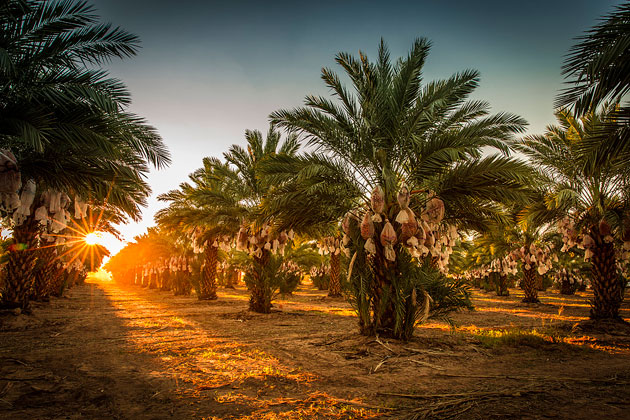Dateline: Medjools, King of Dates

Dates have a lingering air of romance about them – images of caravans arriving at desert oases long ago, of camels greedily drinking while men eat dates below date-laden palms to renew their energy. The sweet fruit has been a staple of the dessert tray in turnovers or squares (best known in Western Canada as matrimonial cake), but now chefs are finding novel and delicious ways to use them in every menu course – and for good reason.
Sweet they may be, but fresh dates such as the Medjool dates grown in the Bard Valley, between Phoenix, Ariz., and San Diego, Calif., are gluten-free, sodium-free, kosher, and high in potassium and manganese. They rate low to medium on the glycemic index, lessening the fluctuations of blood sugar levels while maintaining energy. And eat two Medjools and you’ll be inputting three grams of fibre, which is equal to 12 per cent of the fibre you should consume each day. This fibre helps lower cholesterol and triglyceride levels, reducing risk of heart disease.
You’ll find Natural Delights Medjool Dates produced by the Bard Valley Date Growers Association (an alliance of family-owned and operated date gardens) in the produce department of Canadian grocery stores. Refrigerate to retain the fruit’s freshness.
To explore their flavour potential, let the natural date sweetness bounce off the saltiness of goat or cheddar cheese. Better yet, wind a small piece of smoked bacon or pancetta around a date and bake. Or try replacing the pits with peanut butter or dried tart cherries or cranberries. Delectable recipes for Medjool date, avocado, and kiwi salsa on sea scallops; Medjool date and citrus barbecue sauce; and savoury Medjool date and nut pasta; and others, can be found at www.naturaldelights.com.
Here’s an unusual and healthful recipe, adapted by Emily Richards and Jo Lusted from Jerusalem, a cookbook by Yotam Ottolenghi and Sami Tamimi.
(Click through for recipe.)
Hot Yogurt & Barley Soup
1 cup (250 mL) pearl barley
6 cups (1.5 L) water
1 tsp (5 mL) salt
3 tbsp (45 mL) unsalted butter
2 onions, finely diced
1 ½ tsp (7 mL) dried mint
2 eggs, whisked
2 cups (500 mL) plain Greek yogurt
12 Natural Delights Medjool Dates, pitted and finely chopped
½ cup (125 mL) chopped fresh mint
¼ cup (60 mL) chopped fresh flat-leaf parsley
3 green onions, thinly sliced
⅓ cup (75 mL) coarsely crushed toasted almonds
¼ cup (60 mL) extra virgin olive oil
Sea salt and freshly ground black pepper to taste
Instructions:
Bring barley and water to a boil in a large saucepot. Add salt, reduce heat to a simmer and cook until barley is al dente, about 15-20 minutes. Keep warm.
While barley is cooking, heat butter in a large skillet over medium heat. Add onions and dried mint and cook, stirring frequently, until softened, about 15 minutes. Add onion and mint mixture to saucepot with barley.
Whisk eggs and yogurt together in a large stainless bowl. Slowly whisk about ¼ cup (60 mL) of the warm barley mixture at a time into the yogurt mixture, until it is tempered and warm. This will keep the mixture from splitting when you add it to the pot. Add yogurt mixture to the barley saucepot and return to medium heat, stirring continuously, until soup comes to a very light simmer. Do not let it boil.
Remove from heat and season with salt and pepper. Stir in Medjool dates, fresh mint, parsley and green onions, reserving about ¼ of each for garnish. Divide into bowls and top evenly with reserved garnish, toasted almonds and olive oil.
Makes 8 servings.
DID YOU KNOW?
In 1927, a disease threatened the Moroccan Medjool date palms, so an American scientist brought healthy cuttings of the trees to Nevada to preserve samples of the species. Descendants of those cuttings were transplanted to the Bard Valley in 1944 – the introduction of the date growing industry there. Six of those original transplants still produce more than 90 kilograms of dates each year.
Date palms thrive in the Bard Valley’s low humidity and on its high water table, caused by its proximity to the Columbia River.
It takes eight to 10 years before a date palm yields a crop.
Growers sometimes sell date palms to landscapers in Las Vegas or Florida, where they lend a tropical air to the scenery. The trees don’t bear fruit in highly humid areas like Florida.
Date cultivation is labour intensive. Workers are lifted up and down the trees several times during the growing season, hand pollinating the female blossoms, thinning dates so those remaining can grow large and full, covering them to protect from birds and finally, harvesting them. —JM